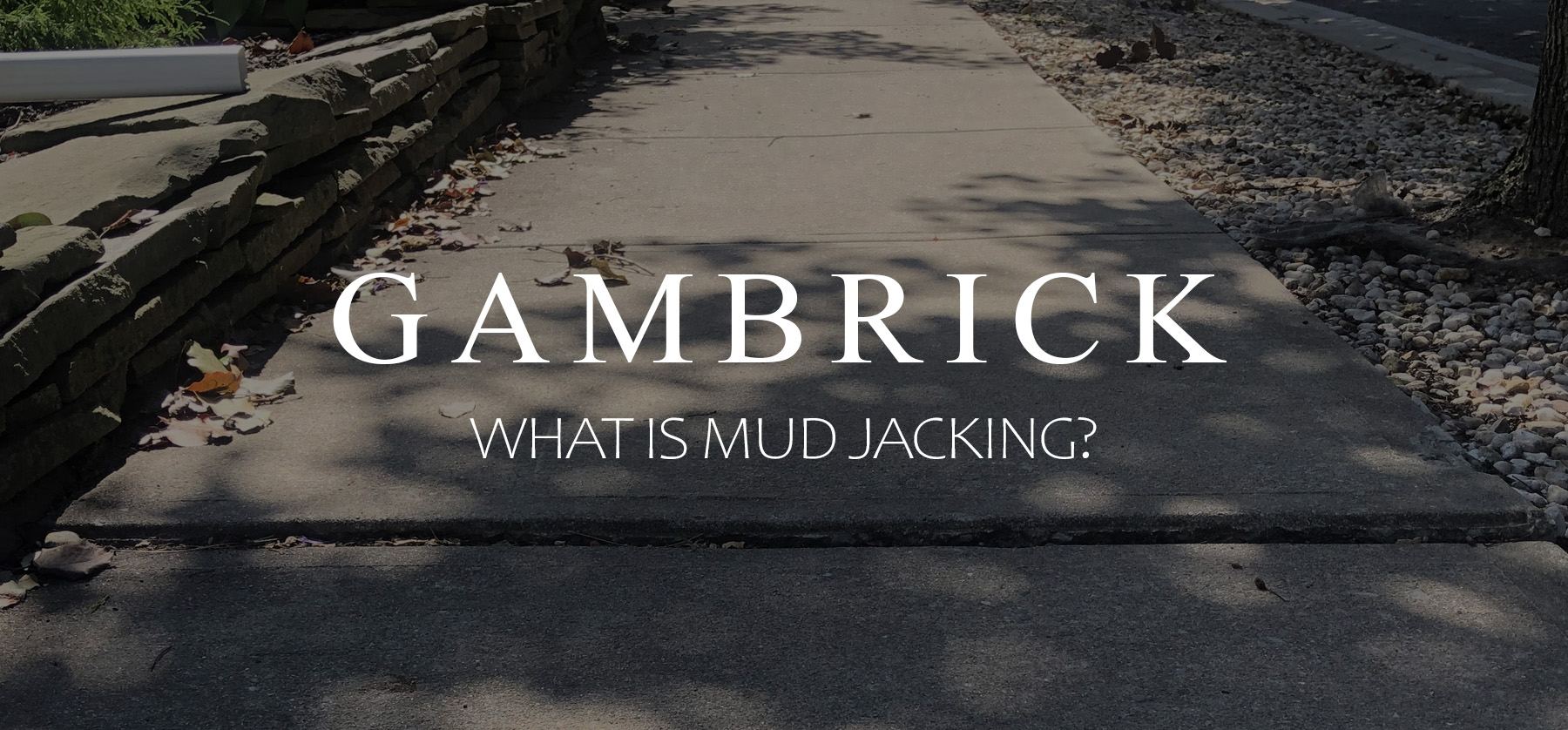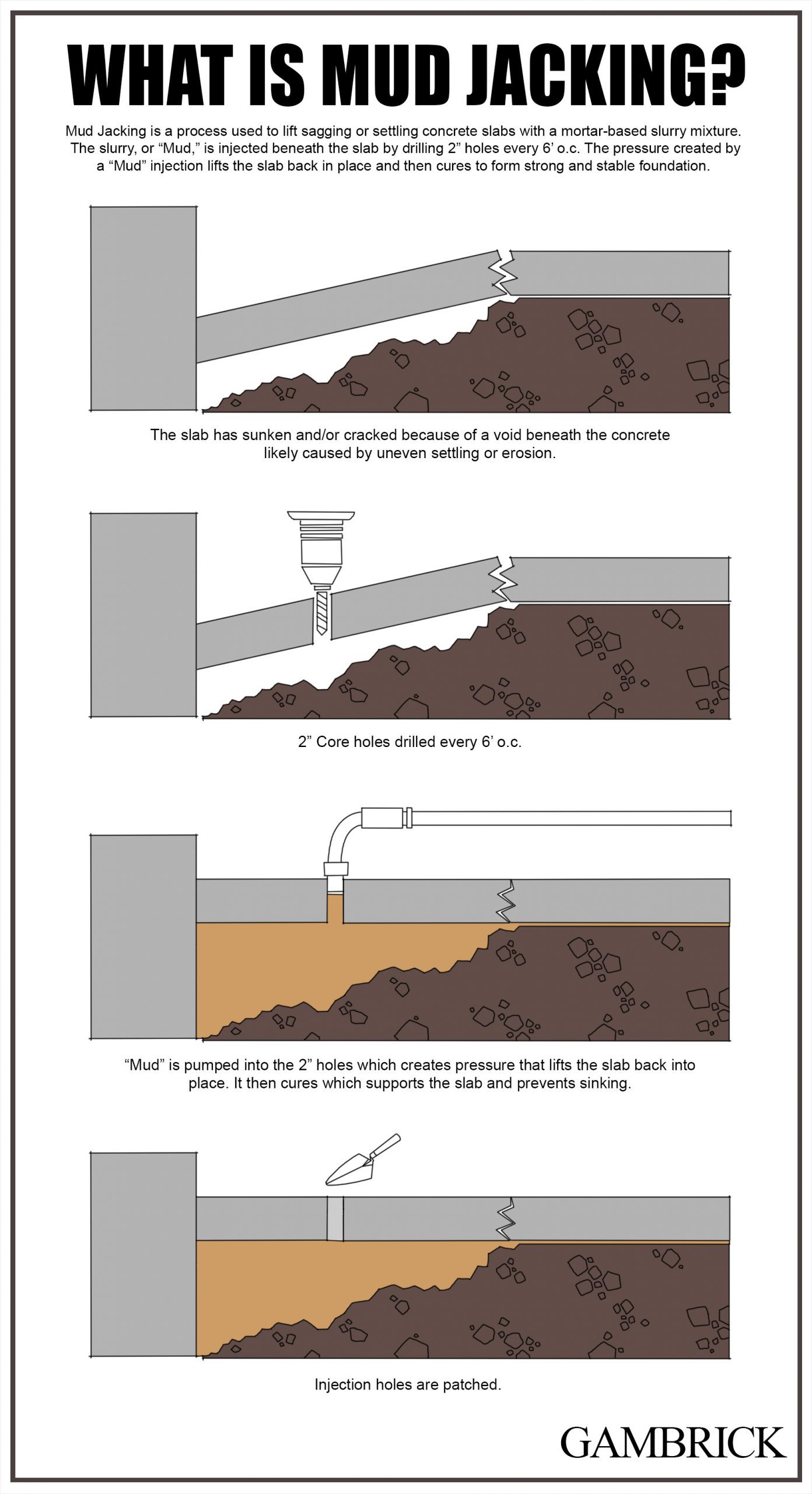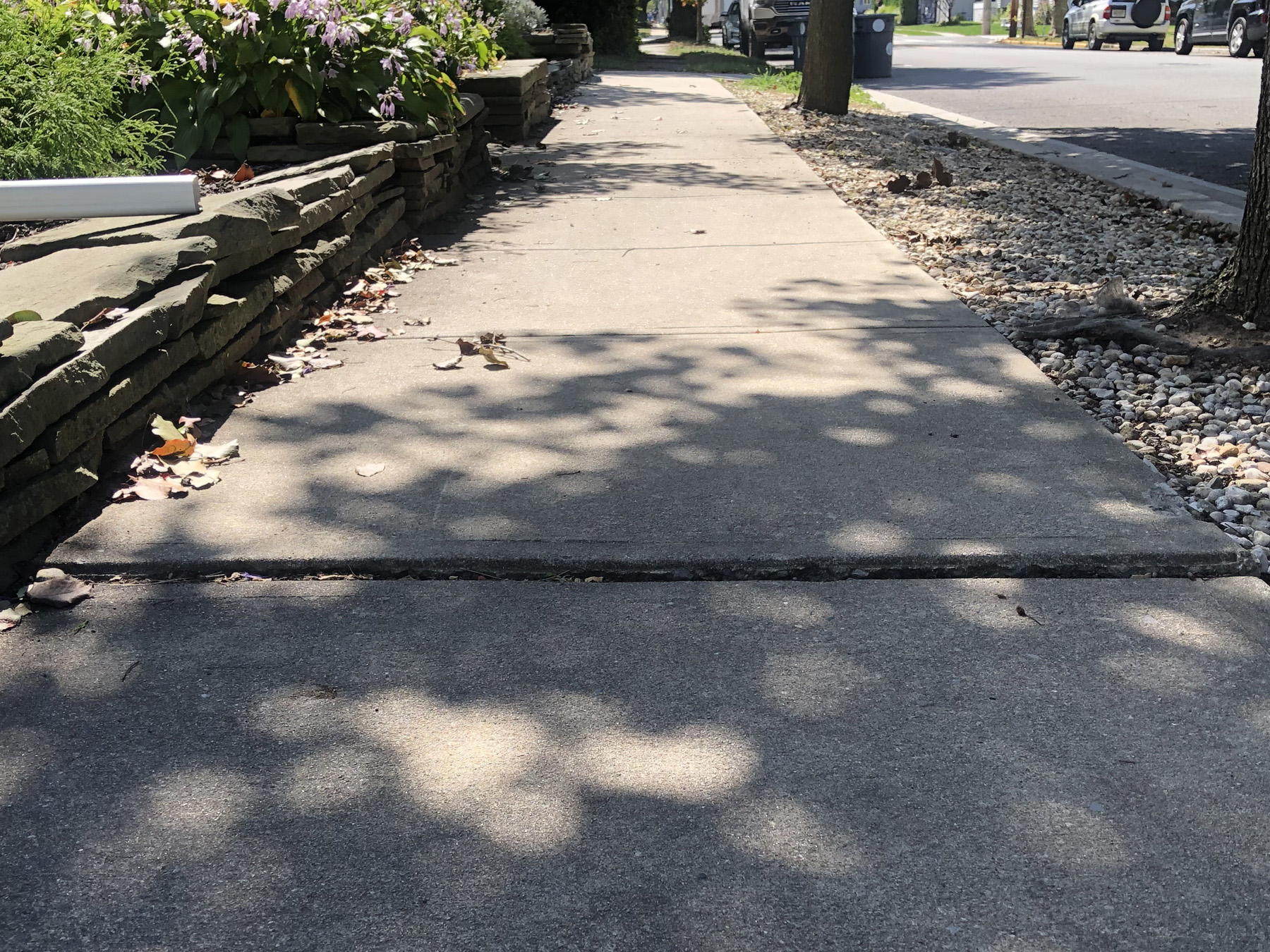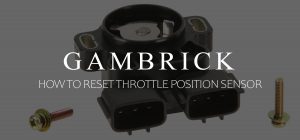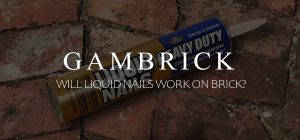What Is Mud Jacking?
Mud Jacking is a process used to lift settling concrete slabs by injecting a mortar-based slurry mixture called “Mud” under the slab. The slurry, or “mud,” is injected into the void beneath the slab through 2 inch diameter holes drilled every 6 foot o.c. The injected “mud” creates enough pressure to lift the slab back into place. Once the void is filled and the slab is back in position, the holes are patched. The slurry then cures over time to create a strong and stable foundation for the slab.
The process is called Mud Jacking because it uses a mortar-based slurry mixture called “Mud” to “Jack” up a sinking concrete slab. The process is similar to jacking up a car only instead of using a jack to create pressure, Mud Jacking uses injected “Mud”.
The most common reason a concrete slab settles, sinks and cracks is a poorly a compacted sub-grade or soil erosion. When a concrete slab is poured, the area is first excavated. Then a base of gravel is poured which provides support for the slab and drainage. Both the soil and gravel need to be well compacted before concrete is poured. If compaction isn’t done properly, the soil or gravel will eventually settle which creates a void beneath the slab.
A void is an unsupported area of concrete which allows the slab to sink or and/or crack.
Another reason why voids can form under a slab is soil erosion. If water washes away soil or gravel from under the slab it creates a void. Like settling, voids are an unsupported area of concrete that’s prone to settling and/or cracks.
Luckily Mud Jacking can fix a sinking concrete slab while providing a strong and durable base for it to rest.
How Mud Jacking Is Done
Hydraulic Mud Jacking involves drilling 2″ holes trough a sinking concrete slab every 6′. Slurry is then hydraulically pumped into the holes filling voids under the slab.
The high pressure lifts and levels the slab back into its original position. Then the slurry cures which creates a solid foundation for the slab.
Once the slab is in place, the injection holes are filled with color-matched non-shrink grout, mortar or fresh concrete. But in most cases, you can still see the outline of the holes after repairs are made.
Mud Jacking can be used with high pressure to lift slabs that are in good shape. or low pressure to lift concrete that’s brittle or has cracks.
When done right, Mud Jacking is highly effective and provides long-lasting results up to a decade in most cases.
The process is fairly quick depending on the size of the job. Most projects can be completed in just a few hours.
Once the slurry has fully cured, the slab can bear heavy loads.
What Is Mud Jacking Also Called?
There are a few different terms used in construction to describe Mud jacking. But the process is the same no matter what term you call it. Drilling holes through a concrete slab followed by pumping material under the slab which raises it back into place. The material stays under the slab to create a solid foundation at the desired height.
Here are a few of the terms used to describe Mud Jacking:
- Slab Jacking
- Concrete Lifting
- Concrete Raising
- Grout Pumping
- Slab Leveling
- Slab Raising
Step 1. Drilling Holes
The first step is measuring and marking where the injection holes will be drilled. A 2 inch hole will be drilled every 6 feet on average. However the exact location depends on how the slab is settling. Some slabs only need 2 to 3 to be jacked back into position.
A mason will inspect the slab and try to figure out why it’s settling. Based on what he finds, holes will be marked in the areas that need to be lifted.
be careful where the holes are drilled because you’ll be able to see the circles after the slab is lifted and patched.
More than one hole is always drilled. By drilling multiple holes the mason has more control over how the slab moves as its lifting. 3 to 5 holes is the average amount needed for a slab.
Holes should be kept at least 6 inches away from the edges to prevent cracks.
Once all the holes are marked, a hammer drill and a diamond masonry bit are used to do the drilling. Holes should be drilled entirely through the slab from the surface to the void. The average slab is 4 inches however some can be much thicker so bring a long drill bit just in case.
Drilling through concrete creates a lot of dust and heat. Use water to cool the bit and reduce dust.
Step 2. Lifting The Slab
Step 2 in the Mud Jacking process is injecting the slurry.
Once all the holes are marked and drilled, a nozzle is inserted into the holes. Then the slurry is pumped through the holes and into the void below the slab. Once the void is completely filled, pressure builds up and starts to life the concrete.
The angle and height of the slab can be slightly adjusted by changing the hole getting pumped. This is why so many holes are drilled into the slab.
As material is pumped under the slab, it slowly rises back into position.
The “Mud” is called slurry, which is a mix of Portland Cement, topsoil, additives and water that’s combined together to form a fluid that can be pumped through a hose. Not only does slurry raise the concrete from underneath, but it also fills fills the void and cures in place creating a strong and stable foundation for the slab.
Step 3. Finish Work
Once the voids are completely filled with slurry and the slab is back in position, it’s checked. Not only does the slab need to be lifted but also sloped and leveled properly. In most cases a sagging slab sinks unevenly and needs to be leveled on more than one side.
After the slab is checked and set exactly where it needs to be, the surface is cleaned off. Excess slurry shouldn’t be left on top of the concrete or it will harden.
Next, the 2 inch injection holes are filled and leveled off. I use either a mortar mix of sand, Portland Cement, lime and small stones or fresh concrete.
Unfortunately, you will be able to see the circles of fresh concrete left behind by the repair. Over time they start to fade a bit but are generally still noticeable. This is why it’s so important to mark and drill holes uniformly.
If possible, drill holes in areas that can be covered up later by planters.
Pros Of Mudjacking
Mudjacking is a great way to lift and support a sagging concrete slab because of a void beneath.
Here are some of the advantages:
- Mud jacking is less expensive than tearing out the concrete and replacing the slab.
- It takes a lot less time than demolishing and replacing the concrete. Most jobs can be done in under a day.
- Mud jacking is a more Eco-conscious choice because it repairs rather than replaces the concrete.
- The process is less intrusive than a full concrete slab replacement. A replacement requires jack-hammering the slab or using heavy equipment. This means a lot of mess and noise.
- Mudjacking doesn’t disturb the surrounding concrete.
Cons Of Mudjacking
Although mudjacking is a fantastic way to repair a sagging concrete slab, it’s not a one size fits all answer to every concrete problem. Here are a few disadvantages with the process:
- Mudjacking doesn’t repair cracks in the concrete surface. It merely lifts the slab back into place, but the cracks will still be visible. You have to repair them separately.
- The 2-inch round holes used to inject slurry beneath the slab are still visible after the concrete has been lifted.
- Generally, lifting a concrete slab doesn’t disturb the concrete around it. But there’s always a risk when two slabs rub against one another that cracks could form. There could also be damage to finished material installed on top of the slab like tiles.
- It takes skill, experience and the right tools. Mudjacking is not a DIY project.
Is Mud Jacking A Good Idea?
Mud Jacking has some advantages over other types of concrete raising. It can be cheaper, faster and easier to perform and is sometimes a batter solution than demo and replacement of the slab. But the 2 inch holes used to inject slurry beneath the slab are visible after the project is done. This is a major turnoff for some customers who don’t want to see evidence of repair work having been done.
Mud Jacking is not the best solution for structural applications. But for sagging non structural slabs it works great. It’s fast, effective and a lot cheaper than replacing an entire concrete slab.
Mud jacking works best when the slab is in good condition. This is because the issue is with the sub-grade settling and not the slab itself. In some cases, paying money to raise and create a strong foundation for the slab is worth it.
Mud Jacking works on most settled concrete slabs which include:
- Sidewalks
- Porches
- Patios
- Pool decks
- Driveways
- Parking lots
- Basements
- Garage floors
- Concrete steps
When Is Mud Jacking Not A Good Idea?
Mud Jacking is a great way to raise and repair a sagging concrete slab. However, there are some issues that it isn’t a great solution for.
Here are a few examples:
- Potholes
- Foundation repairs
- Old Concrete Slabs
- Old sidewalks that are cracked and sinking
- Pool Repairs
- Pavers
- Extensively damaged concrete that’s crumbled or crushed
- DIY projects. Mud Jacking requires specialized equipment, skill and experience to do. Work should always be done by a trained professional who is familiar with local soil conditions.
- Climates with cold/hot weather extremes
- Areas with poorly compacted soil
Mud Jacking will not fill in surface holes like potholes. The slurry is not a surface material, it works underneath the surface but not on top.
Pool repairs and foundation issues should not rely on Mud Jacking. It’s best for sinking flat slabs like driveways, sidewalks and patios.
Pools and foundations are extremely heavy and support a lot of weight. Mud Jacking is not meant for structural applications where a failure could be disastrous. Use it to repair simple ground level slabs.
Mud jacking will not prolong the life of a concrete slab. If the concrete is damaged, old or cracked, all Mud Jacking will do is raise it to its proper height. But it doesn’t repair cracks or fix other issues.
If a concrete slab is severely damaged and deteriorating, raising it up is usually not a great fix. In some cases the concrete can get worse due to the added pressure from below. When a slab is in really bad shape the best solution is demolition and replacement.
Mud Jacking works best when the slab is in good shape but sinking. This is because the problem is with the sub-grade and not the concrete.
How Much Does Mud Jacking Cost?
A typical Mud jacking job costs between $800 to $2,000 per slab. It’s a fairly fast process that can usually be done in under a day. Repair materials are cheap and the process is fast which keeps the cost down.
Mud Jacking is a lot cheaper than demolition and replacement of a sagging slab. There’s no demo work, disposal of old concrete, grading, compaction, forming or pouring fresh concrete. All you do is mark and drill holes, pump slurry to level the slab, patch the holes and clean up.
A typical Mud Jacking job can be priced in two different ways.
- Time & materials: Some companies will charge an hourly rate for the service plus the cost of the slurry and patch materials they use.
- Per Slab: Some companies charge a flat rate per slab that they raise.
I prefer hiring companies that give me a set price per slab rather than charging time and materials. This way I know exactly how much the job costs before I agree.
Is Mud Jacking Worth it?
Under the right circumstances Mud Jacking is worth the money. But it’s not a one size fits all answer for every concrete problem. It works best when the slab is in good condition but is sinking. This is because the problem is with the sub-grade and not the slab itself. So raising and re-using the concrete makes sense. But if the concrete is damaged and severely cracked, Mud Jacking may not be worth it because all you’re doing is raising broken concrete.
here are some situations when Mud jacking is worth the money:
- When the concrete is in good condition but sagging.
- If the sinking slab creates a tripping hazard.
- Mud jacking is a quicker fix that’s a lot less expensive than a full replacement. it can buy you time if the slab is still in OK shape.
Every sinking slab is a little different. If you have a sinking slab with one or two cracks, Mud Jacking along with crack repairs can be a good solution. However, if the concrete is severely cracked I would replace it instead.
Is Mud Jacking A Permanent Fix?
Yes, when done correctly Mud Jacking is a permanent fix. The slurry that’s pumped beneath the slab cures to create a strong and stable foundation for the slab. A typical job can easily last a decade or more without further sagging. However Mud jacking does not repair the concrete slab or soil. If the slab has settled due to settling or soil erosion, the problem can continue even after Mud Jacking is complete.
The slurry injected under a concrete slab to raise it is very heavy. This new weight in addition to the weight of the slab can induce settling. For this reason it works best on strong and stable soil. if your soil is unstable and prone to settling or erosion, Mud jacking may not be the best option.
Can You Do Mud Jacking Yourself?
No. Mud Jacking is not a DIY project that you can do yourself. It involves special equipment to drill holes through the slab and to inject slurry beneath the slab. In addition to specialized tools, you also need experience and skill to do the job right. Simply drilling holes and pumping “Mud” under a slab won;t lift it perfectly into its original position. You have to know where to drill the holes and how to pump the slurry in order to raise a slab into place.
How Long Does It Take Mud Jacking To Cure?
After injection is complete, Mud Jacking can take anywhere between 24 to 72 hours to cure. After this time you can put full weight onto the slab. However, curing continues very slowly for a few weeks. The exact time it takes for slurry to cure depends on moisture content, soil conditions, temperature and the ingredients used to make the slurry. Additives can be mixed into the slurry to speed up cure times.
How Long Does Mud Jacking Last?
When done correctly, Mud Jacking typically lasts for over a decade. But how long it lasts depends a lot on the installation, soil conditions and slab. If the soil is poor and continues to settle after lifting is done, Mud Jacking won’t last long. It will only last as long as the soil remains stable.
Mud jacking doesn’t repair the slab, it merely lifts it. If slab cracks aren’t properly repaired or the concrete continues to crack, slab raising won’t last as long. It only lasts as long as the slab remains in good condition.
If your slab settled due to soil erosion and you jack it back into place, Mud jacking won’t fix the erosion problem. Soil under the “Mud” can continue to erode and sink the slab.
To get the most out of Mud Jacking and make it last, you should also repair the slab and address any underlying causes of settling.
Can You Mud Jack Broken Or Cracked Concrete?
Yes, Mud Jacking can be done on broken concrete. However the cracks can’t be extensive. One crack in a slab is usually OK to raise if the concrete is still in large pieces. But if the slab is severely broken with lots of small chunks, Mud Jacking won’t work. Also keep in mind that Mud jacking only raises the slab, it doesn’t repair it. Cracks must be repaired separately after the concrete is set in place.
How Long After Mud Jacking Can You Drive?
Vehicles can generally drive on top of a concrete driveway raised by Mud Jacking in about 4 to 6 hours. But it depends on the driveway and the weight of the car or truck. If the slab is in good condition and only needed to be raised, you can drive on it the same day. However, if the slab was broken and needed crack repairs, you should wait at least a day for the fresh concrete or mortar to harden.
Can You Mud Jack A Garage Slab?
Yes, Mud Jacking is a great way to restore a sagging concrete garage floor to its proper height. It’s actually a better solution inside a garage than for a driveway because the floor can be painted afterward which covers the injection holes.
Can You Mud Jack In The Winter?
Yes, Mud Jacking can be done in Winter if the temperature, weather and ground conditions allow it. This means above freezing so that ground water won;t be frozen under the slab. If Mud Jacking is done when there’s frozen water under the slab, it will eventually thaw and drain out which creates a void. It’s also not a great idea to raise a slab during rain, snow or icy conditions for safety reasons.
How Do You Make Mud Jacking Slurry?
Mud Jacking Slurry is made by mixing the following materials together: sand, clay or topsoil, limestone dust and Portland cement. These materials are mixed together thoroughly and then mixed with water to create a mud-like material. This is where the name Mud Jacking Comes from.
The formula for Mud Jacking Slurry can be altered a bit depending on the local soil conditions. When complete, it weighs about 100 lbs per cubic foot of material.
Summary: What Is Mud Jacking?
Mud Jacking is a process used to lift settling concrete slabs by injecting a mortar-based slurry mixture called “Mud” under the slab. The slurry, or “mud,” is injected into the void beneath the slab through 2 inch diameter holes drilled every 6 foot o.c. The injected “mud” creates enough pressure to lift the slab back into place. Once the void is filled and the slab is back in position, the holes are patched. The slurry then cures over time to create a strong and stable foundation for the slab.
The process is called Mud Jacking because it uses a mortar-based slurry mixture called “Mud” to “Jack” up a sinking concrete slab. The process is similar to jacking up a car only instead of using a jack to create pressure, Mud Jacking uses injected “Mud”.
The most common reason a concrete slab settles, sinks and cracks is a poorly a compacted sub-grade or soil erosion. When a concrete slab is poured, the area is first excavated. Then a base of gravel is poured which provides support for the slab and drainage. Both the soil and gravel need to be well compacted before concrete is poured. If compaction isn’t done properly, the soil or gravel will eventually settle which creates a void beneath the slab.
A void is an unsupported area of concrete which allows the slab to sink or and/or crack.
Another reason why voids can form under a slab is soil erosion. If water washes away soil or gravel from under the slab it creates a void. Like settling, voids are an unsupported area of concrete that’s prone to settling and/or cracks.
Luckily Mud Jacking can fix a sinking concrete slab while providing a strong and durable base for it to rest.
If you have any questions email any time.
